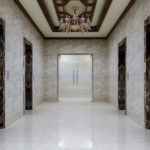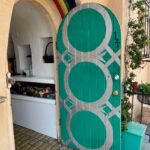The 2010 California Fire Code requires fire doors to be maintained in accordance with NFPA 80 and smoke doors to be maintained in accordance with NFPA 105. The code references the 2007 editions of NFPA 80 and NFPA 105 (Chapter 47 – Referenced Standards). The 2007 editions of these standards require the door assemblies to be inspected annually as part of the maintenance requirements, so by referencing NFPA 80-2007 and NFPA 105-2007 for maintenance of fire doors and smoke doors, an annual inspection of these assemblies is required.
 Here is the text from the 2010 California Fire Code:
Here is the text from the 2010 California Fire Code:
SECTION 703 – FIRE-RESISTANCE-RATED CONSTRUCTION
703.1 Maintenance. The required fire-resistance rating of fire-resistance-rated construction (including walls, firestops, shaft enclosures, partitions, smoke barriers, floors, fire-resistive coatings and sprayed fire-resistant materials applied to structural members and fire-resistant joint systems) shall be maintained. Such elements shall be visually inspected by the owner annually and properly repaired, restored or replaced when damaged, altered, breached or penetrated. Where concealed, such elements shall not be required to be visually inspected by the owner unless the concealed space is accessible by the removal or movement of a panel, access door, ceiling tile or similar movable entry to the space. Openings made therein for the passage of pipes, electrical conduit, wires, ducts, air transfer openings and holes made for any reason shall be protected with approved methods capable of resisting the passage of smoke and fire. Openings through fire-resistance-rated assemblies shall be protected by self- or automatic-closing doors of approved construction meeting the fire protection requirements for the assembly.
703.1.1 Fireblocking and draftstopping. Required fireblocking and drafts topping in combustible concealed spaces shall be maintained to provide continuity and integrity of the construction.
703.1.2 Smoke barriers and smoke partitions. Required smoke barriers and smoke partitions shall be maintained to prevent the passage of smoke. All openings protected with approved smoke barrier doors or smoke dampers shall be maintained in accordance with NFPA 105.
703.1.3 Fire walls, fire barriers and fire partitions. Required fire walls, fire barriers and fire partitions shall be maintained to prevent the passage of fire. All openings protected with approved doors or fire dampers shall be maintained in accordance with NFPA 80.
703.2 Opening protectives. Opening protectives shall be maintained in an operative condition in accordance with NFPA 80. Fire doors and smoke barrier doors shall not be blocked or obstructed or otherwise made inoperable. Fusible links shall be replaced promptly whenever fused or damaged. Fire door assemblies shall not be modified.
703.2.1 Signs. Where required by the fire code official, a sign shall be permanently displayed on or near each fire door in letters not less than 1 inch (25 mm) high to read as follows:
1. For doors designed to be kept normally open: FIRE DOOR-DO NOT BLOCK.
2. For doors designed to be kept normally closed: FIRE DOOR-KEEP CLOSED.
703.2.2 Hold-open devices and closers. Hold-open devices and automatic door closers, where provided, shall be maintained. During the period that such device is out of service for repairs, the door it operates shall remain in the closed position.
703.2.3 Door operation. Swinging fire doors shall close from the full-open position and latch automatically. The door closer shall exert enough force to close and latch the door from any partially open position.
If you know of a jurisdiction within the state of California that is enforcing fire door inspections, please leave a comment.
For more information about fire door assembly inspection, visit the FDAI page of this blog.
You need to login or register to bookmark/favorite this content.





Hi Lori,
In California we are starting to see pockets of enforcement. I know we have had a number of Door Security and Safety Foundation presentations, as well as individual Certified Fire Door Inspectors in our state trying to help educate the regulatory community about the new code changes. I believe it’s just a matter of time before more consistent enforcement of the code is required throughout California.
Thanks Hal! Let me know if you hear of any specific cities requiring inspections.
Hi Lori!
Just getting started with this requirement in our specifications, requires coordination with Division 01 for close-out third-party inspections. Requiring Contractor to deliver a report to the Owner from a third-party inspection service documenting zero defects (what a concept, eh?). We are alerting distributors about the requirement (you know they’re not gonna read the front end), they can include/exclude in their bids as they see fit.
Talked to lots of fire prevention officials at their recent convention, most are at least vaguely aware of the requirement for annual inspections, but common thread is that their budgets have been cut 50% to 80%, and they’re all rather harried. All the more reason for enforcing third-party inspection.
I’ll keep you posted as to acceptance/enforcement.
I understand that the 3rd party inspectors must obtain a certification to do so, correct?
NFPA 80 does not require an inspector to be certified. The standard requires the inspectors to be conducted by a qualified person, which is defined in the standard as: “A person who, by possession of a recognized degree, certificate, professional standing or skill, and who, by knowledge, training, and experience has demonstrated the ability to deal with the subject matter, the work, or the project.”